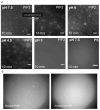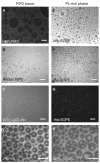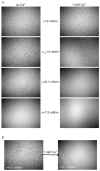Calcium-dependent lateral organization in phosphatidylinositol 4,5-bisphosphate (PIP2)- and cholesterol-containing monolayers
- PMID: 19630438
- PMCID: PMC2774806
- DOI: 10.1021/bi9007879
Calcium-dependent lateral organization in phosphatidylinositol 4,5-bisphosphate (PIP2)- and cholesterol-containing monolayers
Abstract
Biological membrane function, in part, depends upon the local regulation of lipid composition. The spatial heterogeneity of membrane lipids has been extensively explored in the context of cholesterol and phospholipid acyl-chain-dependent domain formation, but the effects of lipid head groups and soluble factors in lateral lipid organization are less clear. In this contribution, the effects of divalent calcium ions on domain formation in monolayers containing phosphatidylinositol 4,5-bisphosphate (PIP2), a polyanionic, multifunctional lipid of the cytosolic leaflet of the plasma bilayer, are reported. In binary monolayers of PIP2 mixed with zwitterionic lipids, calcium induced a rapid, PIP2-dependent surface pressure drop, with the concomitant formation of laterally segregated, PIP2-rich domains. The effect was dependent upon head-group multivalency, because lowered pH suppressed the surface-pressure effect and domain formation. In accordance with previous observations, inclusion of cholesterol in lipid mixtures induced coexistence of two liquid phases. Phase separation strongly segregated PIP2 to the cholesterol-poor phase, suggesting a role for cholesterol-dependent lipid demixing in regulating PIP2 localization and local concentration. Similar to binary mixtures, subphase calcium induced contraction of ternary cholesterol-containing monolayers; however, in these mixtures, calcium induced an unexpected, PIP2- and multivalency-dependent decrease in the miscibility phase transition surface pressure, resulting in rapid dissolution of the domains. This result emphasizes the likely critical role of subphase factors and lipid head-group specificity in the formation and stability of cholesterol-dependent domains in cellular plasma membranes.
Figures






Similar articles
-
Cholesterol-Dependent Phase-Demixing in Lipid Bilayers as a Switch for the Activity of the Phosphoinositide-Binding Cytoskeletal Protein Gelsolin.Biochemistry. 2016 Jun 21;55(24):3361-9. doi: 10.1021/acs.biochem.5b01363. Epub 2016 Jun 9. Biochemistry. 2016. PMID: 27224309 Free PMC article.
-
Apical membrane segregation of phosphatidylinositol-4,5-bisphosphate influences parathyroid hormone 1 receptor compartmental signaling and localization via direct regulation of ezrin in LLC-PK1 cells.Cell Signal. 2011 Oct;23(10):1659-68. doi: 10.1016/j.cellsig.2011.05.020. Epub 2011 Jun 7. Cell Signal. 2011. PMID: 21672629 Free PMC article.
-
Divalent cation-induced cluster formation by polyphosphoinositides in model membranes.J Am Chem Soc. 2012 Feb 22;134(7):3387-95. doi: 10.1021/ja208640t. Epub 2012 Feb 10. J Am Chem Soc. 2012. PMID: 22280226 Free PMC article.
-
Plasma membrane phosphoinositide organization by protein electrostatics.Nature. 2005 Dec 1;438(7068):605-11. doi: 10.1038/nature04398. Nature. 2005. PMID: 16319880 Review.
-
Inositol and PIP2/PIP3 Ratio: At the Crossroad of the Biodynamic Interface Between Cells and Their Microenvironment.Biomolecules. 2025 Mar 20;15(3):451. doi: 10.3390/biom15030451. Biomolecules. 2025. PMID: 40149987 Free PMC article. Review.
Cited by
-
Sec14-nodulin proteins and the patterning of phosphoinositide landmarks for developmental control of membrane morphogenesis.Mol Biol Cell. 2015 May 1;26(9):1764-81. doi: 10.1091/mbc.E14-10-1475. Epub 2015 Mar 4. Mol Biol Cell. 2015. PMID: 25739452 Free PMC article.
-
Quantum and all-atom molecular dynamics simulations of protonation and divalent ion binding to phosphatidylinositol 4,5-bisphosphate (PIP2).J Phys Chem B. 2013 Jul 18;117(28):8322-9. doi: 10.1021/jp401414y. Epub 2013 Jul 3. J Phys Chem B. 2013. PMID: 23786273 Free PMC article.
-
Phosphatidylinositol 4,5-bisphosphate clusters act as molecular beacons for vesicle recruitment.Nat Struct Mol Biol. 2013 Jun;20(6):679-86. doi: 10.1038/nsmb.2570. Epub 2013 May 12. Nat Struct Mol Biol. 2013. PMID: 23665582 Free PMC article.
-
Localization of phosphatidylinositol 4,5-bisphosphate to lipid rafts and uroids in the human protozoan parasite Entamoeba histolytica.Infect Immun. 2013 Jun;81(6):2145-55. doi: 10.1128/IAI.00040-13. Epub 2013 Apr 1. Infect Immun. 2013. PMID: 23545298 Free PMC article.
-
Counterion-mediated pattern formation in membranes containing anionic lipids.Adv Colloid Interface Sci. 2014 Jun;208:177-88. doi: 10.1016/j.cis.2014.01.016. Epub 2014 Jan 30. Adv Colloid Interface Sci. 2014. PMID: 24556233 Free PMC article. Review.
References
-
- Esposti MD. Lipids, cardiolipin and apoptosis: a greasy license to kill. Cell Death Differ. 2002;9:234–236. - PubMed
-
- Lawrence T, Willoughby DA, Gilroy DW. Anti-inflammatory lipid mediators and insights into the resolution of inflammation. Nat Rev Immunol. 2002;2:787–795. - PubMed
-
- Yin HL, Janmey PA. Phosphoinositide regulation of the actin cytoskeleton. Annu Rev Physiol. 2003;65:761–789. - PubMed
-
- Eling TE, Glasgow WC. Cellular proliferation and lipid metabolism: importance of lipoxygenases in modulating epidermal growth factor-dependent mitogenesis. Cancer Metastasis Rev. 1994;13:397–410. - PubMed
-
- Czech MP. PIP2 and PIP3: complex roles at the cell surface. Cell. 2000;100:603–606. - PubMed
Publication types
MeSH terms
Substances
Grants and funding
LinkOut - more resources
Full Text Sources
Medical

